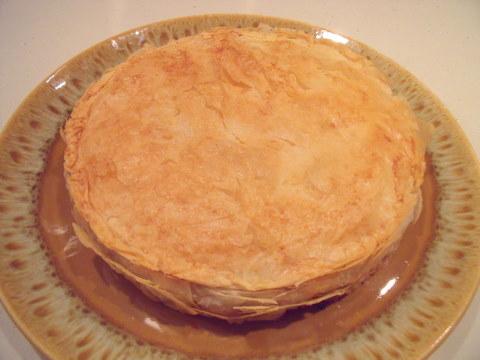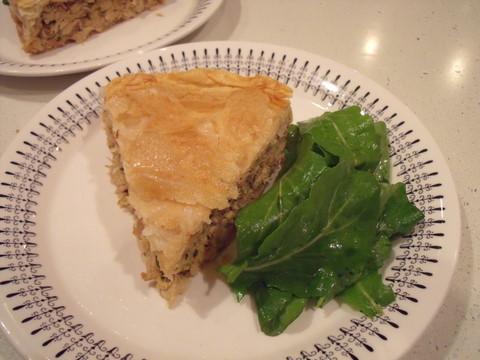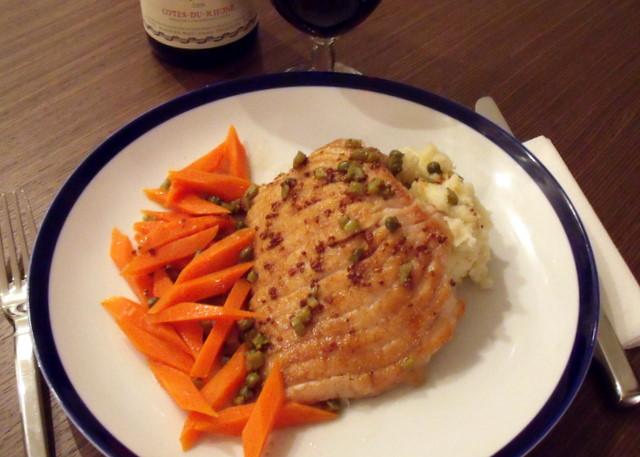
LindaK
eGullet Society staff emeritus-
Posts
3,028 -
Joined
-
Last visited
Content Type
Profiles
Forums
Store
Help Articles
Everything posted by LindaK
-
Cooking with Dorie Greenspan's "Around my French Table"
LindaK replied to a topic in France: Cooking & Baking
Pierre Hermé’s Olive Sablés, pp. 12-13 Delectable! Brilliant! Sweet and savory, delicate and earthy--in every bite. Not at all difficult. Just follow Dorie's instructions and don't work the dough much once the olives have been added or they'll stain the dough. Since the dough needs to be made in advance, it's perfect for keeping on hand in the fridge for holiday parties or unexpected guests. I'll be making this often in the next month, I'm sure. -
What a lovely thing for you to do. With so many options, I wonder if you can't somehow elicit a bit more information so you can at least narrow down the style to either (1) chunky stew in broth or (2) thick puree. Once you decide which direction you're taking, I'm sure anything you make will be be delicious and very much appreciated.
-
This is just a brief note to say thanks! Great eG Forums topics like this one wouldn't be possible without the financial support of our non-profit Society's sponsors and donors. Your financial contributions pay for forum upkeep and many exciting Society projects in the works. I know I speak on behalf of all volunteers in saying thank you for your support. Doing your holiday shopping online? Remember this season that you can donate to Gully without spending a dime! Simply use the We-Care.com donation system when you make your purchases or connect to Amazon.com through this eGullet-friendly link. Now back to the food -- and thanks!
-
Interesting how different chocolate mousse recipes can be. The problem you describe is one I've had only with leftover mousse after many days, maybe a week, sitting in the fridge, when it starts to separate. It hardly ever lasts that long anyway. I could not have offered you the beautifully detailed critique of your recipe that chiantiglace provided, my hat's off. My basic recipe could not be more different but I've been making it for years and it has not yet failed me. Credit to Patricia Wells, "Bistro Cooking." 8 oz/250 g bittersweet chocolate 4 oz/120 g unsalted butter 8 large egg yolks 1/2 cup/100 g sugar 5 large egg whites flavorings such as vanilla (I always use it), coffee, grand marnier, etc. good luck!
-
Just in time for holiday baking...I am thinking about adding this to my list. These look luscious and so much easier than the traditional method. Bruce, I am not clear as to whether your two-day soak in syrup was before or after baking.
-
One reason people whose culinary education began with her have such strong feelings is that she was a natural, brilliant teacher. It isn't just that she taught us so much--she did so in the most relaxed and unfussy way possible, and conveyed a complete conviction that we could do it too. Despite the relaxed approach, her great respect for the importance of proper technique and culinary tradition always came through. That made a big impression on me at the time. Cooking was something you could take seriously, worthy of the time it took to do it correctly. ScoopKW's point is valid for other cultures too. Her influence wasn’t just introducing us to French food, it was opening our minds to new culinary traditions and respect for authenticity. It allowed others to do the same, as cookbook editors still love to point out. Here are just a few quotes from the jackets of some of the cookbooks on my shelves: “Marcella Hazan has done for Italian food what Julia Child and Simone Beck did for French.” "Madhur Jaffrey is the Julia Child of Indian cookery.” “He [Rick Bayless] does for Mexican cooking what Julia Child did for French cooking.”
-
If it's only 2 weeks, I wouldn't freeze it either. But once I found myself with several whole small cheeses, italian robiola due latte, that I knew I would never use in a short time--so I froze them and used them over several months. They were surprisingly okay, flavor still good, texture a little soft but not mushy. It wouldn't plan for it, but it beat throwing them out.
-
How about stuffed grape leaves? Vegetarian versions (I use rice, fresh herbs, onion, currants, a little lemon zest) are inexpensive and will keep and travel well.
-
Oven racks- how many do you need and do you clean them?
LindaK replied to a topic in Kitchen Consumer
Mine came with three, two standard and one full-extension rack. That has always seemed like one too many for me. I keep two in the oven at all times (one regular and the full-extension), moving them around as necessary. The third sits sad and alone in my pantry. As for cleaning, I have yet to clean them (they've been in residence two years now). That doesn't mean they don't need it. -
Cooking with Dorie Greenspan's "Around my French Table"
LindaK replied to a topic in France: Cooking & Baking
Creamy cauliflower soup sans cream, p. 68-69 It sure tastes like it has cream. Very rich flavor but with almost no fat. I love Dorie’s suggestions for toppings, from the simple to the sublime. I had neither caviar nor truffles around the house, but I did use a pinch of truffle finishing salt on top--nice. Something about the cauliflower really carried the flavor. Dorie isn’t exaggerating when she says that this is an elegant recipe worthy of your best china. I, on the other hand, just used a favorite mug: -
Earlier today, local brewery Boston Beers (maker of Samuel Adams) created some buzz with the announcement that they'd partnered with the world's oldest brewery, Weihenstephan, in Germany to create a champagne-like ale. Labeled "Infinium," it's a limited release that will be on the shelves for the holidays. Short story in the Boston Globe here.
-
Cooking with Dorie Greenspan's "Around my French Table"
LindaK replied to a topic in France: Cooking & Baking
Chicken B’stilla, p. 222 Creamy, subtly spiced chicken in a buttery phyllo crust—-what’s not to love? This made a perfect supper dish last night for out-of-town friends. I wanted something special but not fussy, that would be good hot or at room temperature, and that could be made ahead. This was time consuming but not difficult—-with a few lessons learned for the next time. Prep time for the filling is several hours, but only a bit of that is hands-on work and the entire filling can be done the day before—-that’s what I did. The chicken needs to marinate, then simmer in broth. Once the meat is off the bone, the broth is strained and is used for the sauce. Assembly isn’t difficult, just take care handling the phyllo so it doesn’t tear. The one tricky step is unmolding the b’stilla. Only once it was in the oven, baking away nicely, did it dawn on me—-the b’stilla would need to be unmolded onto a platter and then reversed again onto the serving platter. My initial reaction was fear—-flipping phyllo? twice? it would shatter to bits! My second thought was—-duh, why didn’t I use a springform pan? The damage was limited, and I proclaimed the b'stilla as rustic. My guests were impressed and had seconds. But is there any reason not to use a springform pan here? It would make unmolding a breeze and help keep that lovely phyllo crust intact. Someone tell me if I’m missing a downside. I don’t have a “before” photo, but trust me, the top and sides were perfectly smooth when it came out of the oven. On the platter: Cut into wedges with a side salad: A couple of tips that might be helpful to others: • The sauce is thickened by whisking beaten eggs into the hot, reduced broth. The recipe didn’t mention tempering the eggs first by adding a little of the broth, something that helps keep eggs from scrambling when added to hot liquid. Seems like a simple precaution. • Also, I found myself a bit confused about how to follow through with the directions to add the cooked, chopped onions from simmering liquid to the final filling. Good idea, except that, once strained from the broth, the onions are mixed with the chopped garlic and usual glop that results when braising meat. Next time, I’ll only cut the onion in half, making it easy to pull it out, I can chop it later. I hope these quibbles don’t discourage anyone from trying it. This is a delicious and special dish, definitely worth the effort. And though it might be heresy, I’ll bet you can improvise a b'stilla with leftover Thanksgiving turkey—-maybe add the spices to some drippings to make the sauce—-and voila! -
Cooking with Dorie Greenspan's "Around my French Table"
LindaK replied to a topic in France: Cooking & Baking
Skate with capers, cornichons, and brown butter sauce, p. 291 Skate is a fish I love to order in restaurants but for some reason have avoided cooking at home. Why? I don’t know. But earlier tonight I stopped by the market, thinking I’d buy swordfish for dinner. There, among the offerings, was skate, glisteningly fresh and one-third the price of the swordfish. What would you have done? I wasn’t worried about recipes but since the French classic of skate with brown butter sauce was my first thought, I checked Dorie’s cookbook and sure enough there was this twist on the traditional recipe. Easy as could be, and really, really tasty if you—like me—enjoy the strong flavors of cornichons, capers, and mustard. A great contrast with the skate, which is such a sweet fish. I love this combination. Served here with potato-parsnip puree and sautéed carrots. -
That's backwards. Exactly my point.
-
I can't compete in the vileness category, but in terms of stupid technique, I still have a vivid memory of watching Martha Stewart doing a show on souffles--and explaining/demonstrating how you always stirred some of the souffle mixture into the beaten egg whites before folding the two together.
-
Savory quick breads are a staple pre-dinner nibble in French homes. They generally include some combination of cheese, diced ham, olives, and herbs. Anna N made the Savory Cheese and Chive Bread from Dorie Greenspan's "Around my French Table." Pictured here, described here. As others have suggested, using the term salé (literally salted but meaning savory) as opposed to sucré (sweet) might help your search.
-
Jean, I picked up a used copy of this cookbook over the summer but have yet to cook from it. Thanks for bumping up the topic. In addition to sandwiches, your leftovers would probably be good in tacos or empanadas.
-
I was in St. Louis last week and had a few restaurant meals. The one dinner was at Franco, in the Soulard neighborhood, where I once lived. A good meal, not innovative but well done. Starters were excellent and portions were big--the pates were especially memorable. For a main I had pecan crusted trout with french lentils and root vegetables (perfectly cooked and seasoned carrots and parnips--how often are you wowed by root vegetables?). Big loft space, casual atmosphere, good service. The carte de vins was odd, short with no real focus. The waitress couldn't answer any questions about the wine but to her credit offered to consult with staff who could. Of my two potential choices she came back to recommend the least expensive of the two, which turned out to be lovely. If you are in the neighborhood, Franco is worth checking out. We had tried unsuccessfully for last minute reservations at Niche and Sidney Street Cafe, both nearby. Niche is new since my time in StL but if Sidney Street is still as good as it once was, I would recommend it in a heartbeat, I was sorry not be to be able to visit again. My favorite lunch was at an old haunt, the Shlafly Brewery/Tap Room not far from downtown @ 20th and Locust. We started with fried frog legs and spiced shrimp, went on to great burgers with perfect hot, skinny french fries served with homemade spicy ketchup and green peppercorn mayo for dipping. And let's not forget the excellent microbrewed beers--mine was a Scottish ale, really smooth. Upstairs, good local music in the evenings, though sadly I didn't have time during this visit.
-
Welcome to eG! this is the sort of group project that we love, so I hope you take any criticism as constructive. There are a lot of interesting ideas here (a pork sundae? you've come to the right place!) but I also think Chris A. is asking the right question about the "story" you want to tell with this meal. I would echo the caution about the numerous sweet flavors that appear in all your savory dishes. Butterscotch (though a duck fat butterscotch does sound divine), marshmallow (twice!), peanut butter, bubble gum...I could not get through a menu with this many sweet elements. Interestingly, while I agree with Chris that the bubble gum shot seems out of place, I can say that you have some good instincts with some of the flavor combos in that course. One of the best desserts I ever had was a vanilla souffle with a grapefruit-tarragon granita on the side. who knew? it was sublime.
-
Codfish cakes, made with salt cod of course. I loved these so much I'd usually be stealing spoonfuls of the uncooked mixture before my mother fried them up. Swedish pancakes for dinner. Much like big crepes, very eggy. As a kid it was always a treat to have pancakes for dinner. And half the fun was trying to decipher the cryptic handwritten recipe from my grandmother, which somehow never failed to amuse us kids.
-
Same here. For some pasta I use all semolina, I love the flavor and the firmness, and am lucky to have a local source for it. Wherever you find it, it does need to be very finely milled. I remember the first time I tried to make pasta, using a semolina flour that was coarsely ground, not knowing any better. Disaster.
-
thanks xxchef, that's insightful and wise advice. I thought of this topic yesterday afternoon, halfway though a sit-down lunch for 30 that I made for my mom's 70th birthday. Compliments were flowing and though the meal was very good, I knew it wasn't perfect. Ordinarily I would have recounted its flaws, but that suddenly seemed very selfish. All that really mattered was that my mother loved it and was flattered by the obvious effort that had gone into it, and that guests were fighting for leftovers. You're right, I didn't need to share my self-critique. I learned from the minor flaws, that's enough.
-
The talk was part of an engineering course and a longer lecture series at the Engineering School at Harvard. See the schedule for the current semester here: http://seas.harvard.edu/cooking There are still some good lectures to go: Wylie Dufresne, Dan Barber, David Chang. It's quite the lineup. Tickets go quickly but for those without tickets or far away from Cambridge, MA, they are also streamed live. There's a link in the upper right corner of the site above. You'll also see a course syllabus further down the page, in the column to the right.
-
Cooking with Dorie Greenspan's "Around my French Table"
LindaK replied to a topic in France: Cooking & Baking
It is indeed! The name is an homage to Antoine Augustin Parmentier, who introduced potatoes into French cuisine in the 18th century--in France, potatoes were previously grown only as an ornamental plant. So when you see a dish on a French menu with Parmentier in the name, you know it includes potatoes. -
I've got a glass backsplash and I love it. I'd post a pic but mine are all mid-construction photos and my camera battery is dead at the moment. To clarify, mine is glass tile, 6x12" subway tiles. I love the look of one big glass sheet but those are really, really expensive custom products. Plus, I can't help but worry about any breakage. If one of my tiles gets cracked, no big deal. If you need an entire backspash replaced...$$$$...though they are made of tempered glass and tougher than you'd think. A couple of things I learned from my experience. Glass tiles or sheets are very tricky to install. Glass--even the back-painted glass that is standard for these installations--reflects every imperfection in the back mortar and grout. If those are not perfectly smooth, you'll see it. For that reason, installation is not the average DYI project. And professional installation for glass ends up being more expensive than standard tile because it takes more time. But lovely when it's done right.





